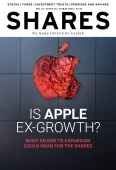Archived article
Please note that tax, investment, pension and ISA rules can change and the information and any views contained in this article may now be inaccurate.
Investors alert to new twists and turns in the weight-loss drug revolution

There have been two major pieces of news regarding weight-loss drugs in recent weeks, adding further evidence that we’re seeing one of the biggest healthcare revolutions in decades. It’s also feeding into the investment world with more stocks being drawn into the conversation.
A new study concluded that weight-loss drugs could halve the risk of obesity-related cancers. Cancer experts said the findings published in The Lancet’s eClinicalMedicine were significant and could herald a ‘whole new era of preventive cancer medicine’.
We also had results from the first comprehensive head-to-head study of two popular weight loss-drugs which showed that Eli Lilly’s (LLY:NYSE) Zepbound is more effective than Novo-Nordisk’s (NOVO-B:CPH) Wegovy treatment. The study, published in the New England Journal of Medicine found Zepbound led to 20.2% weight reduction after 72 weeks of treatment among 750 obese people, versus 13.7% from Wegovy.
The latter study confirms what investors already thought was the case – namely that Eli Lilly is winning the weight-loss drug race, with its share price having also outperformed Novo Nordisk’s.
ROOM FOR MORE THAN ONE WINNER?
One might have thought the market opportunity is so large that there’s plenty of room for multiple companies to prosper. That might still be the case, yet the fact that Novo-Nordisk’s shares in April hit their lowest level since November 2022 would suggest that a majority of investors are backing Eli Lilly as the ultimate champion.
Part of that decision will have been influenced by disappointing news flow from Novo-Nordisk. The Danish company has been running trials for the next generation of its weight-loss treatments and made the grave mistake of being too optimistic with guidance to investors.
NOVO-NORDISK’S BIG MISTAKE
Last November, Novo-Nordisk’s then-chief executive Lars Fruergaard Jørgensen told the Financial Times that he was confident late-stage data for its CagriSema weight-loss treatment would show the drug cuts weight by 25% in just over a year – versus 16% for Wegovy and up to 22.5% for Eli Lilly’s Mounjaro drug when administered alongside lifestyle interventions such as improved diet, exercise and sleep.
Company bosses need to under-promise and over-deliver to keep the market on side, and the opposite happened with Novo-Nordisk. The CagriSema trial showed ‘only’ 22.7% of body-weight loss and that news wiped approximately €90 billion off the company’s market value.
In March, Novo-Nordisk disappointed once again with drug trial results, this time in patients who were obese or overweight and with type 2 diabetes where CagriSema failed to show a clear superiority to Eli Lilly’s Zepbound drug.
Investors may not be surprised to learn that Fruergaard Jørgensen’s mistakes cost him his job, with the company saying on 16 May that he was stepping down.
ENTERING THE MAINSTREAM
Against a backdrop of market rivalry, there’s been an important structural shift in the market (particularly in the UK) whereby the use of weight-loss drugs is no longer the preserve of celebrities and politicians. It’s truly gone mainstream, with growing use among the general public as individuals seek to shed weight without having to resort to fad diets. These drugs suppress the appetite and users naturally eat less. The treatments have even been attributed to the downfall of slimming club Weight Watchers which recently filed for bankruptcy.
With demand going through the roof for weight-loss drugs, why is it that Eli Lilly’s shares have lost momentum since autumn 2025 and Novo-Nordisk’s shares have remained weak, even after recent drug trial setbacks were priced in?
There are two possible answers. First is that the pharmaceutical sector is in Donald Trump’s firing line – he’s already announced plans to cut US drug pricing and at the time of writing, tariffs were expected to be placed on the industry. Second is that Eli Lilly and Novo-Nordisk face competition from multiple angles. Other pharma giants like AstraZeneca (AZN) and Roche (ROG:SWX) are developing treatments in this area, but equally important from an investment perspective is the threat of generic ‘copycat’ rivals on the horizon.
PATENT CLIFF
The active ingredient in Mounjaro and Zepbound, called tirzepatide, expires in 2036 and after that date rivals can produce their own versions. That’s not such a worry for investors, but the same cannot be said for Wegovy (or Ozempic as it is sometimes known). It uses an active ingredient called semaglutide and Novo Nordisk’s patent runs out next year in Brazil, Canada, China and India, meaning we’re on the cusp of yet another major milestone in the weight loss drug revolution as generics hit the market.
Generic drugs typically sell at a much lower price than ones with patent protection. On the plus side, a drop in price for weight loss drugs could lead to greater usage as the treatment becomes more affordable. Generic producers will be hoping for high sales volumes and that includes FTSE 100 stock Hikma Pharmaceuticals (HIK) which is reportedly in talks with partners to capitalise on the opportunity as soon as possible. Expect to hear more people talk about Hikma in the coming months as the market wakes up to what’s going on.
US-listed Waters Corp (WAT:NYSE) makes medical equipment used in clinical testing and is also seen to be a potential beneficiary of the generic weight loss drug movement. Comments in a recent Reuters article say it has seen a ‘spurt in demand’ from drug makers in India racing to develop generic versions of Novo-Nordisk’s Wegovy and Ozempic.
NOT A PASSING FAD
There is clearly a lot of moving parts to this segment of the healthcare sector, yet the fundamental drivers are clear. Investors would be wise to keep abreast of developments as this doesn’t look like a passing fad like the Atkins or Keto diets. It’s changing people’s lives and the applications stretch beyond weight loss which makes it even more powerful.
Studies have shown weight-loss treatments could also lower the risk of heart attacks and potentially lead to fewer cases of dementia, among other benefits. That said, investing is never that straightforward and there are key risks to consider, even in ‘hot’ areas of the market. The benefits of these drugs are still being explored, and so too are the downsides given they could involve more worrying side effects than a feeling of nausea. It means this sector must not be seen as a no-brainer cure for all investment portfolios.
Important information:
These articles are provided by Shares magazine which is published by AJ Bell Media, a part of AJ Bell. Shares is not written by AJ Bell.
Shares is provided for your general information and use and is not a personal recommendation to invest. It is not intended to be relied upon by you in making or not making any investment decisions. The investments referred to in these articles will not be suitable for all investors. If in doubt please seek appropriate independent financial advice.
Investors acting on the information in these articles do so at their own risk and AJ Bell Media and its staff do not accept liability for losses suffered by investors as a result of their investment decisions.
Issue contents
Ask Rachel
Editor's View
Feature
Great Ideas
News
- It’s business as usual for contractor Costain as shares hit five-year high
- Victorian Plumbing shares hit new low as group plans MFI comeback
- What tender offer means for Polar Capital Global Financials Trust investors
- Moody's cuts US credit rating
- These are the stocks ‘guru’ investors have been buying and selling this year
- Buy into chemicals company Victrex at an attractive valuation
 magazine
magazine








